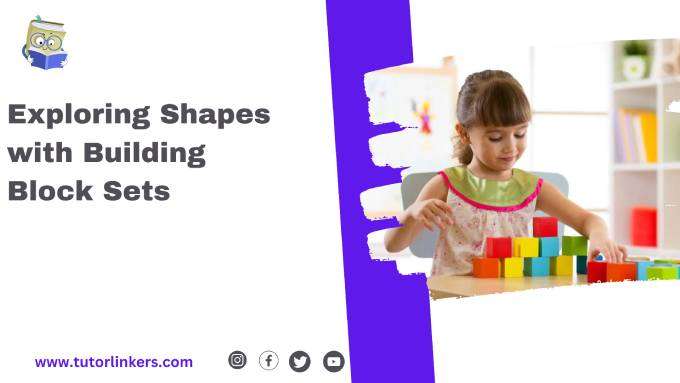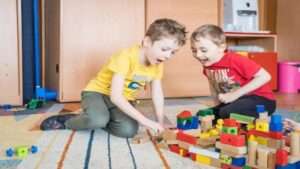Exploring Shapes with Building Block: In the world of early childhood education, learning shapes is a fundamental step towards understanding geometry and spatial relationships. Building block sets offer a captivating and hands-on approach to shape recognition, making learning engaging and enjoyable for young learners. In this blog post, we’ll delve into the world of online tutor services and building block sets for learning shapes, exploring their benefits, types of shapes covered, popular examples, educational value, effective usage strategies, and the importance of parental involvement in shape learning.
Understanding shapes is a crucial aspect of early childhood education as it lays the foundation for mathematical thinking and problem-solving skills. Building block sets provide a dynamic and interactive platform for children to explore geometric concepts through play. By incorporating shape learning into playtime activities, children develop a solid understanding of shapes and spatial awareness.
2. Benefits of Building Block Sets for Learning Shapes
Building block sets offer numerous benefits for shape learning:
- Promotes Hands-On Learning: Children engage in tactile exploration by manipulating blocks to create various shapes and structures.
- Enhances Spatial Skills: Assembling blocks into different shapes fosters an understanding of spatial relationships and dimensions.
- Fosters Creativity and Problem-Solving: Building challenges encourage creative thinking and strategic problem-solving, promoting critical thinking skills.
3. Types of Shapes Covered
Building block sets cover a range of shapes, including:
| Shape Type | Description | Examples |
|---|---|---|
| Circles | Round shapes with all points equidistant from the center | Wheels, Coins, Clocks |
| Triangles | Three-sided polygons | Equilateral, Isosceles, Scalene |
| Rectangles | Four-sided polygons with opposite sides equal and all angles at 90 degrees | Doors, Windows, Books |
| Squares | Special type of rectangle with all sides equal | Post-It Notes, Tiles |
| Polygons | Closed plane figures with straight sides | Pentagons, Hexagons, Octagons |
| Other Geometric Shapes | Various geometric figures not classified under specific categories | Ellipses, Parallelograms, Trapezoids |
4. Popular Building Block Sets for Learning Shapes
Let’s explore some popular building block sets designed for shape learning:
- LEGO® DUPLO® My First Shapes: Tailored for preschoolers, this set introduces basic shapes through colorful blocks and building activities.
- Magna-Tiles®: Features magnetic tiles that enable children to construct various 2D and 3D shapes with ease.
- Tegu Magnetic Wooden Blocks: Combines traditional wooden blocks with magnets, offering endless possibilities for shape exploration and construction.
5. Educational Value of Building Block Sets
Building block sets provide rich educational experiences:
| Building Block Set | Educational Value |
|---|---|
| LEGO | Enhances creativity, problem-solving, spatial awareness, and fine motor skills. Encourages imagination and planning. Can be used for learning concepts like symmetry, geometry, and engineering principles. |
| Mega Bloks | Promotes hand-eye coordination, color recognition, and basic construction skills. Encourages imaginative play and fosters creativity. Can be used to introduce simple mathematical concepts like counting and sorting. |
| K’NEX | Supports STEM learning by teaching principles of engineering and physics. Enhances critical thinking, problem-solving, and spatial reasoning. Encourages experimentation and understanding of structural stability. |
| Lincoln Logs | Develops fine motor skills, hand-eye coordination, and logical thinking. Encourages creativity and storytelling through building log cabins and structures. Introduces basic principles of architecture and construction. |
| Tinker Toys | Stimulates creativity and imagination. Promotes problem-solving and spatial awareness. Encourages experimentation with different configurations and designs. Supports fine motor skill development. |
In this table:
- Building Block Set: This column lists popular building block sets.
- Educational Value: Describes the educational benefits and skills that each building block set can help develop in children, including cognitive, motor, and creative abilities.
6. How to Use Building Block Sets Effectively
To maximize the benefits of building block sets for shape learning:
- Incorporate Guided Activities: Provide structured lessons or prompts to focus on specific shapes or constructions.
- Encourage Open-Ended Play: Allow children to explore shapes freely and creatively, fostering independent discovery and experimentation.
- Integrate with Storytelling: Use blocks to create scenes or narratives incorporating shapes, promoting imaginative play and storytelling skills.
7. Benefits for Different Age Groups
Building block sets cater to learners of all ages:
- Toddlers and Preschoolers: Introduce basic shapes and encourage tactile exploration through simple building activities.
- Elementary School Age: Explore more complex shapes and spatial concepts through structured challenges and group projects.
- All Ages: Provide opportunities for collaborative learning and peer interaction with building block sets.
8. Parental Involvement and Home Learning
Parents play a crucial role in supporting shape learning at home:
- Suggestions for Parents: Tips for integrating shape learning into everyday routines and playtime activities.
- Importance of Play-Based Learning: Highlight the benefits of playful learning experiences in promoting cognitive and social development.
9. Conclusion
In conclusion, building block sets offer a versatile and effective tool for introducing children to the world of shapes and geometry. By engaging in hands-on exploration and creative play with building blocks, children develop essential mathematical skills and a lifelong appreciation for learning. Embrace the power of building block sets to ignite curiosity and shape young minds!
10. Call to Action
Ready to embark on a shape-learning adventure with building block sets? Explore the diverse range of block sets available, choose your favorites, and embark on a journey of discovery and creativity with your child. Let’s build a strong foundation of mathematical thinking one block at a time!
Read MORE: Math board games for practicing arithmetic
FAQ’s
1. What age group are these building block sets suitable for?
Building block sets like LEGO, Mega Bloks, K’NEX, Lincoln Logs, and Tinker Toys are generally designed for children aged 3 years and above. However, the specific age recommendations can vary depending on the complexity and size of the pieces within each set. It’s essential to check the packaging and product descriptions for age guidelines provided by the manufacturer. Some sets may have smaller pieces that are not suitable for very young children due to choking hazards. Always supervise young children during play with building block sets to ensure safe and appropriate use.
2. How do building block sets benefit child development?
Building block sets offer numerous benefits for child development. They promote fine motor skills as children manipulate and assemble pieces. These sets also encourage creativity and imaginative play, allowing children to design and build various structures. Furthermore, building block play enhances problem-solving abilities and spatial awareness as children learn to visualize and construct in three dimensions. Many building block sets can also introduce basic STEM (science, technology, engineering, and mathematics) concepts such as symmetry, balance, and simple engineering principles.
3. Are these building block sets safe for children?
Most reputable building block sets prioritize safety and use non-toxic materials that meet safety standards. However, parental supervision is crucial, especially for younger children, to ensure safe play and prevent potential choking hazards. It’s essential to follow the age recommendations provided by the manufacturer and choose sets that are developmentally appropriate for your child’s age and skill level. Regularly inspect building block pieces for wear and tear, and discard any broken or damaged parts to maintain a safe play environment for children.
Ehsan Ali is a seasoned content writer and researcher with a talent for translating complex concepts into clear, engaging content. With a deep understanding of human behavior, societal trends, and technical topics, Ehsan creates insightful and impactful content that resonates with a broad audience. His expertise ensures that each piece is both accessible and compelling, bridging the gap between intricate details and everyday understanding.





